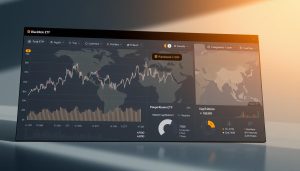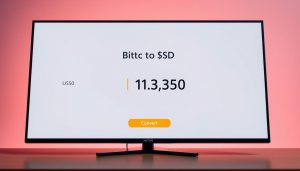The precious metal market just saw its sharpest correction in months. Gold December futures settled at $4,137.80 per troy ounce internationally. Domestically, futures ended at Rs 1,23,451 per 10 grams on MCX.
The current gold price per gram is a living market. It responds to Federal Reserve announcements and global conflicts. Understanding this dynamic is crucial for beginners.
This correction stemmed from profit-booking as the US dollar rebounded. Geopolitical tensions also eased. That’s actually created some interesting entry points for potential buyers.
This guide explores the gold rate today per gram. We’ll use market data, expert analysis, and lessons from costly mistakes. Our aim is to build your knowledge foundation.
You’ll learn what you’re really buying when purchasing gold by the gram. This understanding is key to making informed decisions in the precious metals market.
Key Takeaways
- Gold futures recently settled at $4,137.80 per troy ounce after a sharp market correction
- The precious metal experienced profit-booking following a two-month record-breaking rally
- US dollar strength and reduced geopolitical tensions triggered the recent selling pressure
- Understanding per-gram pricing requires tracking multiple market factors beyond daily numbers
- Recent market corrections have created potential entry opportunities for informed buyers
- Federal Reserve policy decisions and global events directly impact daily pricing fluctuations
Understanding Gold Pricing and Its Importance
Gold prices show patterns in their chaos. They respond to events and economic signals. Gold is a financial tool that reacts to global economic forces.
Gold trends reflect broader economic worries. They also mirror currency changes and policy decisions. Understanding price moves helps you spot real investment chances.
What Factors Influence Gold Prices?
Many forces affect gold pricing at once. I learned this after buying during a brief price spike. The price dropped within days.
Key factors in gold market trends include:
- US Dollar Index Rebound: A stronger dollar usually weakens gold. Gold is priced in dollars worldwide.
- Federal Reserve Monetary Policy: Interest rates matter a lot. Lower rates make gold more attractive.
- Geopolitical Tensions: Major conflicts or peace deals create uncertainty. This drives investors to gold as a safe asset.
- Trade Developments: Good trade talks can lower demand for safe assets. Trade wars often boost gold prices.
- Inflation Trends: Rising inflation makes gold more appealing. It helps preserve wealth as currency value drops.
Experts say possible US Fed rate cuts support gold prices. This creates a price floor that many investors miss. They focus too much on short-term changes.
Not every news story affects markets equally. Big policy shifts matter more than small political fights. Learning this took me months of watching.
How is Gold Priced per Gram?
Gold pricing uses troy ounces in global markets. One troy ounce is 31.1035 grams. This differs from the regular 28.35-gram ounce.
Major exchanges set benchmark prices in troy ounces. These prices convert to per-gram rates through division. At $2,000 per troy ounce, pure gold costs about $64.30 per gram.
Purity levels change the price. Pure 24-karat gold gets the full per-gram rate. 18-karat gold is 75% pure, so it’s 75% of the price.
Dealers add fees to the base price. These cover costs and profits. Fees change based on demand and competition.
Knowing this pricing helps you spot fair rates. You can avoid overpaying and negotiate better. I’ve seen very different prices for the same products.
Current Gold Price Per Gram in the US
Gold’s market reflects a recent rally followed by profit-taking. The key is understanding what the price means for buying or selling physical gold. Many overlook the math behind converting international prices to per-gram values.
Friends often make decisions based on incomplete calculations. This can lead to costly mistakes when purchasing gold.
Live Market Data and Sources
Gold December futures settled at $4,137.80 per troy ounce, down 0.19 percent. This equals about $133 per gram for spot gold after conversion.
The spot gold gram value represents wholesale pricing for pure gold in large quantities. Dealers add a premium above spot price when selling to customers.
Premiums vary based on the form of gold:
- Small bars (1-10 grams): typically 5-12% above spot
- Popular coins (American Eagles, Maple Leafs): 3-8% premium
- Jewelry-grade gold: 15-30% or higher due to craftsmanship costs
- Generic rounds: 2-5% above spot
I once bought a 1-gram gold bar at 20% over spot. This mistake cost me an extra $26 on a $130 purchase.
US markets show gold December futures at Rs 1,23,451 per 10 grams, down 0.53 percent. These movements reveal arbitrage opportunities and regional demand differences.
Kitco.com updates spot prices frequently and provides historical charts. Their mobile interface works well for quick checks on the go.
Bloomberg and Reuters offer professional-grade data for serious traders. The World Gold Council explains the reasons behind price changes in weekly summaries.
Gold has support at $4,096-4,060 and resistance at $4,174-4,210 internationally. The crucial level is $3,870 per troy ounce, according to analysts.
Domestic gold likely finds support around Rs 1,22,650-Rs 1,21,400. It faces resistance at Rs 1,24,200-Rs 1,25,100 per 10 grams. These ranges help time purchases effectively.
Historical Price Trends
Gold recently completed a historic two-month rally before the current pullback. Profit-taking after strong moves is normal and healthy for the market.
In early 2023, gold traded around $1,800 per ounce, or $58 per gram. Today’s $133 per gram represents a 129% increase in about two years.
Here’s a table showing key milestones:
| Time Period | Price Per Ounce | Price Per Gram | Percentage Change |
|---|---|---|---|
| Early 2023 | $1,800 | $58 | Baseline |
| Mid 2024 | $2,450 | $79 | +36% |
| Late 2024 | $3,200 | $103 | +78% |
| Current (Early 2025) | $4,138 | $133 | +130% |
This history shows gold’s appreciation potential and volatility. Markets rarely move straight up without pauses. The current 0.19% decline is normal market behavior.
Previous corrections saw prices drop 15% over three months in 2020. In 2013, prices fell nearly 30% over 18 months.
Successful gold buyers understand that volatility is normal. They focus on long-term trends rather than short-term fluctuations.
The recent rally was driven by geopolitical tensions, currency concerns, and safe-haven demand. When these factors change, prices naturally correct.
Gold maintains purchasing power over decades despite fluctuations. An ounce bought for $35 in 1971 buys more today at $4,138.
Graphical Representation of Gold Prices
Visual representations of market data reveal patterns that numbers alone can’t show. Charts and graphs transform raw gold price data into visible market psychology. Creating my own price charts changed how I understood market behavior.
Graphs turn abstract numbers into recognizable patterns. You can spot trends and identify support levels by looking at price movements. Seeing prices on a chart with historical context provides much more insight.
Interactive Charts and Visual Tools
For live gold price chart tracking, I use TradingView.com daily. Their interface lets you overlay timeframes and add technical indicators easily. You can switch between line charts and candlestick charts for different insights.
Candlestick charts show more than just closing prices. They reveal trading ranges and market sentiment during each period. Long wicks on candlesticks indicate price pushback from buyers or sellers.
Goldprice.org offers simpler charts for quick checks or beginners. Both platforms update in real-time, showing current market action as it happens.
Most live gold price chart platforms let you customize timeframes from minutes to decades. This flexibility allows analysis matching your investment strategy. Day traders might focus on hourly charts, while long-term holders prefer yearly views.
Long-term vs. Short-term Trends
Short-term charts show current market mood and trader behavior. The recent correction appears as a downward movement on daily charts after record highs.
Yearly charts show the same correction as a tiny blip in an upward trajectory. Always check both perspectives to avoid hasty decisions based on short-term movements.
Market analysis shows gold trading between $3,970 and $4,280 per troy ounce. Support levels are at $4,096 to $4,060, with resistance at $4,174 to $4,210. These levels become visible when studying price bounce and stall points.
The recent correction followed a two-month bull run, showing typical profit-taking behavior. On a daily chart, this looks dramatic. On a five-year chart, it’s barely noticeable.
Long-term trends respond to fundamental factors like currency policies. Short-term trends react to technical levels, news, and trader sentiment. Both matter, but for different reasons depending on your approach.
For long-term physical gold holders, short-term volatility is mostly noise. But for optimal entry timing, short-term support and resistance levels are crucial. The current support zone might present a buying opportunity.
| Timeframe | Primary Use | Key Factors | Best For |
|---|---|---|---|
| Short-term (Hourly to Weekly) | Timing entry/exit points | Technical levels, trader sentiment, news reactions | Active traders, tactical buyers |
| Medium-term (Monthly to Quarterly) | Identifying trend changes | Economic data, seasonal patterns, market cycles | Swing traders, flexible investors |
| Long-term (Yearly to Multi-year) | Understanding market direction | Currency debasement, central bank policy, global demand | Long-term holders, wealth preservation |
| Very Long-term (Decade+) | Historical context and cycles | Monetary system changes, generational wealth shifts | Strategic portfolio allocation |
Graphs help visualize when prices test important levels versus floating in uncertain ranges. Watch how gold reacts near the $4,096 support level. A bounce confirms support strength, while a break below signals potential decline.
Visual analysis transforms trading into pattern recognition. You’ll start seeing repeated formations like support becoming resistance and breakouts followed by retests. Charts make these patterns obvious in ways raw data can’t.
Key Statistics on Gold Prices
Gold price stats reveal more than numbers. They show the market’s current state. Recent data illustrates how precious metals behave during corrections and consolidation.
Small percentage changes can mean big dollar amounts. A 0.19% drop is significant at four-figure price points. These stats provide context for informed decision-making.
Gold futures are holding above critical support zones. Normal profit-taking follows recent gains. This creates the statistical patterns we see in daily market data.
Recent Price Fluctuations
Gold saw a sharp correction recently. December futures dropped 0.19% internationally to $4,137.80 per troy ounce. Domestic futures fell 0.53% to Rs 1,23,451 per 10 grams.
That 0.19% drop means about $7.86 per ounce lost. For a 100-ounce position, that’s nearly $800 in value change. Those decimal points suddenly matter more.
The 24K gold price is the benchmark. It represents pure gold content. Traders use this for consistent pricing across different markets.
Domestic markets showed a larger decline than international ones. This often reflects local supply-demand dynamics and currency fluctuations. Regional patterns don’t always mirror global trends.
Market volatility remains contained despite these fluctuations. Gold’s expected trading range is between $3,970 and $4,280 per troy ounce. This gives traders a clear framework for potential price action.
The critical support level is $3,870 per troy ounce. Prices above this suggest the long-term uptrend remains intact. A drop below could mean deeper retracement.
Comparisons with Other Precious Metals
Silver’s performance reveals interesting patterns. December futures closed at $48.586 per ounce, down 0.24% internationally. Domestic futures fell 0.70% to Rs 1,47,470 per kilogram.
Silver typically amplifies gold’s moves. This is due to market size and liquidity. Silver trades in a smaller market, leading to more pronounced price swings.
| Metal | International Change | Current Price (per oz) | Domestic Change |
|---|---|---|---|
| Gold | -0.19% | $4,137.80 | -0.53% |
| Silver | -0.24% | $48.586 | -0.70% |
| Gold/Silver Ratio | — | 85:1 | — |
The gold-to-silver ratio is currently around 85:1. This means one ounce of gold buys about 85 ounces of silver. It’s a key data point for metal allocation decisions.
Historically, this ratio has ranged from 40:1 to 100:1. The current 85:1 level suggests gold has been relatively stronger than silver recently.
18K gold trades at about 75% of the 24K price per gram. 14K gold runs about 58% of the 24K rate. This matters when comparing jewelry prices to investment-grade bullion.
Silver’s support level is near $46.50 per troy ounce. Its expected trading range is $46.50 to $51.50 per ounce. This wider range reflects silver’s higher volatility.
Global Demand and Supply Statistics
Recent profit-taking occurred despite ongoing demand from central banks and Asian markets. This suggests a technical rather than fundamental price decline. Traders locked in gains after a strong rally.
Central bank buying remains strong. Major institutions continue adding gold to their reserves. This creates a price floor that wasn’t present in previous decades.
Asian demand, especially from India and China, provides baseline consumption. Wedding seasons and cultural traditions create predictable demand patterns. Market participants factor these into their analysis.
Mine production remains relatively stable. No major new discoveries have flooded the market. Recycling increases when prices are high and decreases when prices fall.
This supply-demand balance explains the orderly correction. Gold is holding its crucial $3,870 level. This indicates buyers are stepping in at that price point.
The distinction between technical and fundamental factors is important. Technical corrections typically resolve quickly. They’re driven by short-term positioning. Fundamental declines require actual demand destruction or supply increases.
Watch that $3,870 support level closely. A break below could signal a deeper correction. Holding above confirms the long-term uptrend remains intact.
Predictions for the Future of Gold Pricing
Gold prices are unpredictable, but tracking economic signals can help understand market trends. Short-term predictions often miss, while long-term factors are more reliable. The key is identifying which indicators matter when prices move.
Useful market analysis relies on evidence-based projections, not speculation. Focus on experts who explain their reasoning. This context reveals whether forecasts account for real economic conditions.
Expert Forecasts and Market Analysis
Manoj Kumar Jain of Prithvi Finmart expects gold to trade between $3,970 and $4,280 per troy ounce this week. This range suggests continued price volatility within defined boundaries. Jain identifies support levels at $4,096 to $4,060 and resistance at $4,174 to $4,210.
Jain noted that “the US shutdown and cooling off in US inflation supported bullion prices at lower levels.” He also pointed out that potential Fed rate cuts support gold and silver prices.
The recent correction was overdue after a two-month historic rally. Economic uncertainty and expectations for easier monetary policy prevent a deeper drop. Gold rarely crashes when central banks signal potential rate cuts.
Long-term gold market trends point toward higher prices over the next decade. Central banks continue accumulating gold reserves, creating persistent institutional demand. Annual mine production only increases global stocks by about 1.5 to 2 percent yearly.
Currency concerns also favor hard assets like gold. Ongoing fiscal deficits and monetary expansion historically benefit gold prices. This trend seems consistent across multiple countries right now.
Economic Indicators to Watch
Three major events will keep gold prices highly volatile in the near term. Each can move markets significantly. Together, they could cause price swings of $50 to $100 per ounce.
The Federal Reserve’s monetary policy meeting is crucial. Lower interest rates reduce the opportunity cost of holding non-yielding assets. Watch the Fed’s “dot plot” forecasts and language around inflation for subtle shifts.
If the Federal Reserve maintains higher rates longer than expected, it creates headwinds for gold prices. Currently, the consensus leans toward eventual cuts as inflation cools. This expectation is already factored into current prices.
The meeting between US President Donald Trump and China’s President Xi Jinping in South Korea is significant. Positive trade developments strengthen the dollar and pressure gold lower. Deteriorating relations boost gold’s safe-haven appeal.
Trade negotiations can move gold prices 3 to 5 percent in a single day. The uncertainty itself tends to support gold even before any actual announcement.
The European Central Bank’s policy review affects the euro-dollar exchange rate, influencing gold pricing dynamics. A stronger euro often correlates with higher gold prices in dollar terms.
Broader economic indicators worth monitoring include:
- Real interest rates: The difference between nominal rates and inflation. When real rates are negative, gold becomes more attractive.
- Dollar strength index: Gold and the dollar typically move inversely. A weakening dollar supports higher gold prices.
- Inflation expectations: Rising inflation expectations historically correlate with gold rallies as investors seek inflation hedges.
- Central bank purchases: Net buying by central banks creates baseline demand that supports prices over time.
The current gold market seems to be in a broader decade-long bull market that started around 2019. This correction looks like a healthy pullback within that larger trend.
Consider keeping some gold allocation in cash equivalents to buy more if prices drop. Your decisions should be based on your risk tolerance and financial situation.
Tools for Tracking Gold Prices
Smart gold investors use apps and calculators to turn price data into market insights. I’ve tested many platforms and found a few gems. These tools provide accurate prices, timely alerts, and real-world purchase calculations.
Strategic market monitoring requires the right tools set up properly. You need systems that work for you automatically.
Mobile Apps for Live Updates
Kitco’s free app is top-notch for serious gold market followers. It offers real-time spot prices with custom alerts for specific thresholds. I use it to track buying opportunities and market trends.
The alert system makes this app invaluable. It watches prices for you, so you don’t have to check constantly.
Goldprice.org’s app includes a gold gram calculator for quick conversions between units and purities. This tool has saved me money when buying jewelry or small bars.
BullionVault’s app is great for those ready to invest. It shows real-time buy/sell spreads and lets you purchase gold stored in professional vaults. Their transparent pricing builds trust that many dealers lack.
These apps help track the gold rally forecasts and key price levels. They monitor support zones and resistance levels that analysts use to predict movements.
Online Price Calculators
Web-based calculators offer deeper analysis for purchase planning. GoldCalculator.com estimates actual costs, including dealer premiums. This matters because spot price doesn’t show what you’ll really pay.
JMBullion.com and APMEX.com reveal current premium structures across the market. Their pricing shows demand trends and helps you choose optimal product sizes.
These sites’ gold gram calculator tools account for real-world factors like inventory and shipping costs. TradingView.com offers free technical charting to help identify good entry and exit points.
| Tool Name | Primary Feature | Best Used For | Cost |
|---|---|---|---|
| Kitco Mobile App | Real-time spot prices with customizable alerts | Monitoring daily price movements and setting action triggers | Free |
| Goldprice.org App | Multi-purity gram calculator with live conversion | Evaluating jewelry and small bar purchases | Free |
| BullionVault | Transparent buy/sell spreads with vault storage options | Accumulating allocated gold with professional storage | Storage fees apply |
| GoldCalculator.com | Premium-adjusted purchase cost estimates | Planning real-world buying budgets | Free |
| TradingView | Technical charting with trend analysis tools | Identifying optimal entry and exit timing | Free basic, paid premium |
Using price alerts, accurate calculators, and charting platforms creates a complete monitoring system. You’ll have up-to-date info for smart investment choices. This toolkit keeps you informed without constant manual checking.
I check charts weekly, dealer premiums every few days, and rely on Kitco alerts. This keeps me informed without making gold tracking a full-time job.
Setting up these tools takes about an hour. That time investment pays off whenever you need quick, reliable price information.
Frequently Asked Questions About Gold Prices
Gold prices spark many questions from investors. I’ve developed practical answers based on recent market trends. Let’s explore the key concerns about the current gold price per gram.
Gold recently dropped from historic highs after a two-month rally. Prices are holding crucial support levels even during these corrections. The Federal Reserve’s potential rate cuts continue supporting gold values despite short-term volatility.
How Often Do Gold Prices Change?
Constantly during market hours. The spot gold price updates in real-time across nearly 24-hour trading windows. Gold moves through Asian, European, and American sessions consecutively.
I’ve seen the current gold price per gram shift by $2-3 within minutes during volatile periods. Federal Reserve announcements create dramatic swings. International political developments can trigger similar rapid movements.
For most investors, checking prices once or twice daily works fine. The major price moves typically happen during specific windows:
- US trading hours: 9:30 AM to 4 PM Eastern time
- London trading sessions: overlap with early US hours
- Asian market openings: Sunday evening US time
- Major economic announcements: scheduled releases
Central bank policy reviews and Federal Reserve meetings create high volatility periods. During these times, price updates become more meaningful to monitor closely.
Is Investing in Gold Worth It?
This question has no universal answer. Gold doesn’t generate cash flow like stocks or bonds. Its value comes from price appreciation and portfolio diversification.
Over decades, gold roughly maintains purchasing power against inflation. It doesn’t typically outperform productive assets like equities during normal economic periods. However, gold can significantly outperform traditional investments during specific periods.
I view gold as portfolio insurance rather than a primary wealth-building tool. I keep about 10-15% of my investments in gold and gold-related assets. This allocation has saved me during stock market turbulence.
Gold isn’t likely to make you rich quickly. It serves as long-term wealth preservation with occasional appreciation opportunities. The current gold price per gram reflects market uncertainty, making gold valuable when other assets struggle.
What Are the Risks Involved?
Price volatility tops the list of gold investment risks. We just saw prices drop from record highs. Anyone who bought at the peak faces paper losses now.
Storage and security risks matter for physical gold. You need a quality safe or bank deposit box. This adds ongoing costs and logistical challenges.
Dealer premiums and buy/sell spreads create immediate losses. You’ll typically pay 3-8% above spot when buying. When selling, you’ll receive 2-5% below spot price.
| Risk Category | Impact Level | Mitigation Strategy | Cost Factor |
|---|---|---|---|
| Price Volatility | High | Long-term holding, dollar-cost averaging | Potential 10-20% swings |
| Storage Security | Medium | Bank deposit box, insured home safe | $50-200 annually |
| Dealer Spreads | Medium | Buy from established dealers, larger purchases | 5-13% round-trip cost |
| Counterfeit Products | Low to Medium | Third-party verification, reputable sources | $25-100 per verification |
| Opportunity Cost | Variable | Balanced portfolio allocation | Potential alternative returns |
Counterfeit risk exists, especially with smaller bars and coins. I only buy from established dealers. For larger purchases over $5,000, I consider third-party verification.
Opportunity cost is a real consideration. Money in gold isn’t in other investments that might perform better. I’ve held gold through periods where it stagnated while stocks doubled.
Gold doesn’t always move with inflation over shorter timeframes. The correlation strengthens over decades but can disconnect for months or years. Understanding these risks and sizing your position accordingly matters more than going all-in.
Gold works best as part of a diversified strategy. Monitoring the current gold price per gram helps time entries during corrections rather than chasing rallies.
Guides for Investors
Buying physical gold can be messy. This guide offers practical steps for safe acquisition. We’ll explore how to fit gold into your financial strategy.
Gold is finding support after a market correction. Analysts advise caution until stability returns. The correction was driven by profit-booking, not fundamental demand destruction.
Purchasing Physical Gold: The Reality Check
My first gold purchase almost ended in disaster. I nearly got scammed with fake bars on Craigslist. This taught me an important lesson.
Dealer selection matters more than saving a few dollars. Stick with established names like APMEX, JM Bullion, and SD Bullion. Local dealers with good BBB ratings are also reliable.
https://www.youtube.com/watch?v=dfzcCIwa380
Expect higher premiums for small quantities under 10 grams. Choose recognizable products like 1-gram bars from PAMP Suisse or Credit Suisse. These are harder to counterfeit and easier to resell.
Always verify your purchases. Invest in a jewelry scale and learn the rare earth magnet test. These simple tools can save you from questionable deals.
For larger purchases, consider products with assay packaging. This adds resale value and buyer confidence. Third-party verification is also an option for big investments.
Understand the full cost structure before buying. Calculate premiums, shipping, and insurance. These can vary widely between dealers and products.
Start small to learn the process. Buy a gram or two first. This trial run can prevent bigger mistakes later.
Portfolio Integration Strategies
Aim for 5-15% of your portfolio in gold. This depends on your risk tolerance and market outlook. I currently have about 12% in gold.
My gold holdings are split into three parts. Physical gold makes up 70%, providing tangible security. Gold mining stocks are 20%, offering leveraged upside.
Gold ETFs fill the remaining 10%. They offer liquidity for quick tactical moves. This mix serves different purposes in my portfolio.
| Allocation Type | My Portfolio % | Primary Benefit | Main Risk |
|---|---|---|---|
| Physical Gold | 8.4% (70% of gold) | No counterparty risk | Storage and liquidity |
| Mining Stocks | 2.4% (20% of gold) | Leveraged upside | Company-specific issues |
| Gold ETFs | 1.2% (10% of gold) | Trading flexibility | Management fees |
| Total Gold Exposure | 12% of portfolio | Diversification hedge | Opportunity cost in bull equity markets |
Rebalancing is crucial. When gold rallies, it can grow beyond your target allocation. Trim back to your target and redeploy to underweight areas.
This systematic approach forces you to sell high and buy low. It’s counterintuitive but mathematically sound. Take profits when gold is high and add positions during corrections.
The current market correction offers a better entry point. If gold holds support at $3,870, buying in the $4,050-4,100 range could be smart.
Dollar-cost averaging is often better than trying to time the market. Buy some now if you’re underweight. Keep some cash for potential lower prices.
Spread purchases over three to six months. This approach leads to reasonable entry prices without timing stress. It also offers psychological benefits.
Authoritative Sources for Gold Price Information
Quality info is crucial when tracking spot gold gram value. I learned this after following websites predicting market collapse weekly. The constant noise became unbearable.
Filtering sources aggressively changed everything. I stopped wasting time on agenda-driven commentary. Instead, I focused on reliable data.
Trusted News Outlets and Financial Data Providers
Bloomberg and Reuters offer the most dependable commodities coverage. Their gold sections include expert analysis and real-time pricing data. The Wall Street Journal provides quality content too.
Kitco.com is my go-to for precious metals news. They gather expert commentary and offer clear historical charts. The World Gold Council releases quarterly reports on global demand trends.
Market Analysts Worth Following
Manoj Kumar Jain from Prithvi Finmart gives specific technical levels. He considers both bullish and bearish factors in his analysis. His forecasts help me understand market movements.
I follow several analysts with different viewpoints. This keeps me from getting stuck in one potentially wrong narrative. The CFTC Commitments of Traders report shows helpful positioning data.
Combining various data sources creates a solid foundation. This approach helps me understand gold markets beyond just watching numbers change.










 Bitcoin
Bitcoin  Ethereum
Ethereum  Tether
Tether  XRP
XRP  Wrapped SOL
Wrapped SOL  USDC
USDC  Lido Staked Ether
Lido Staked Ether  Dogecoin
Dogecoin  TRON
TRON